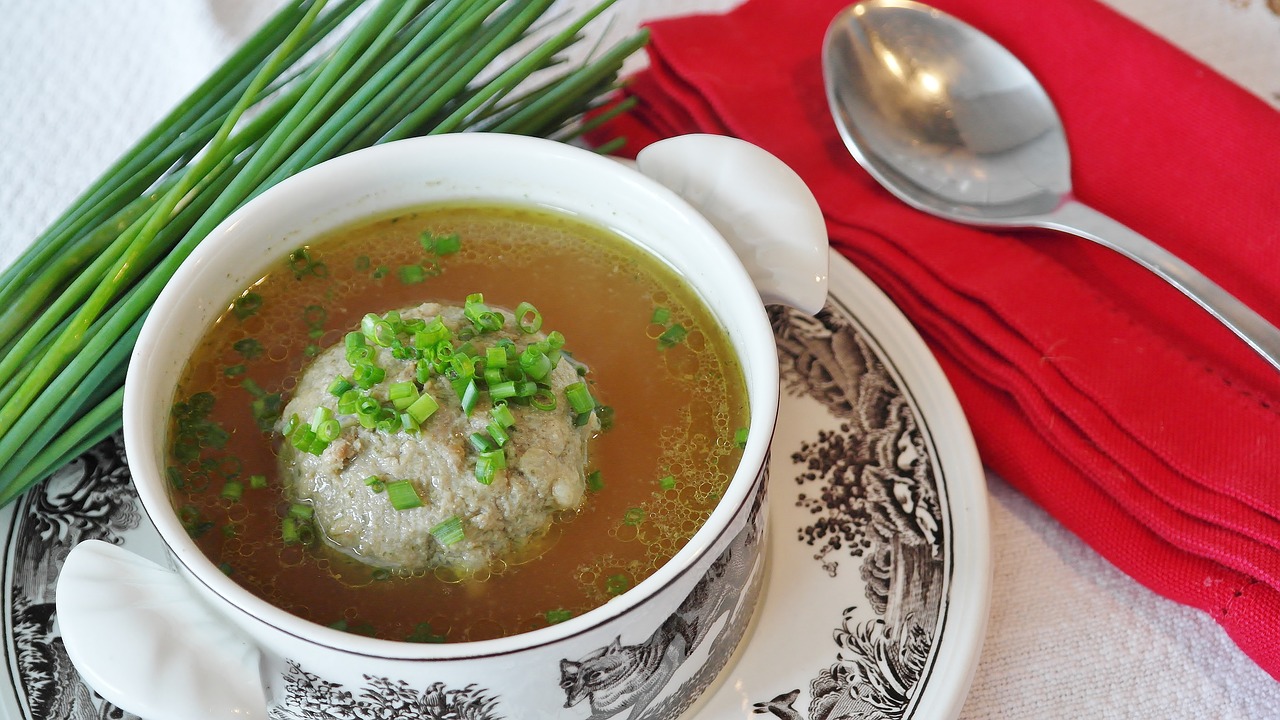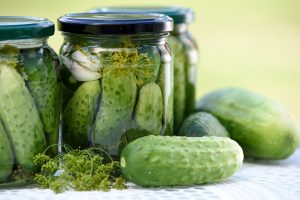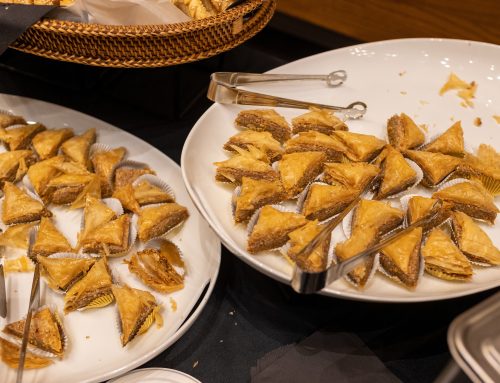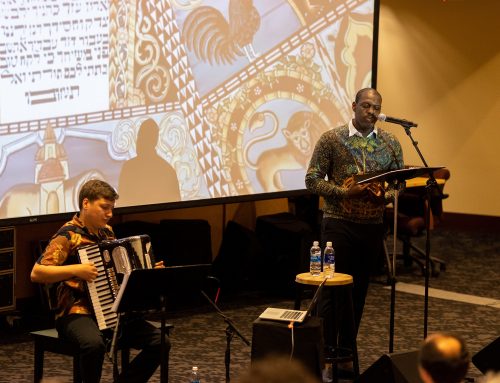
Liver dumpling soup. Photo by Rita E, Pixabay.
By Rachel B. Gross
Scholars of American religious history have long recognized the importance of narratives of decline—stories of a fall from grace. We tell stories about the way things were better in “the good old days” in order to critique our present and make changes for the future.
As I examine in my book manuscript, Feeling Jewish: Longing for Immigrant Pasts and American Jewish Religion, American Jewish organizations and businesses induce nostalgia for particular Jewish pasts as a fundamentally significant way of being Jewish. While nostalgia reduces complicated histories to an accessible narrative—a story of decline—it also produces personal and communal meaning and creates community through shared feelings.

Image: RitaE, Pixabay
One of the narratives of decline (a “declension narrative”) that I trace in my study—and will explore in a talk at the University of Washington on December 7—is the decline-and-revival narrative of American Jewish food. According to this narrative, Ashkenazi Jewish food, derived from Eastern European foodways, used to be a conveyer of Jewish authenticity. As many American Jews grew more distant from their families’ Eastern European immigrant pasts and the ethnic urban neighborhoods where they settled in the United States, the quality of their food declined, as did its authenticity. According to this nostalgic narrative, a return to older forms of food production will result not only in tastier food, but in Jews being more connected to their communal and familial histories.
A lot of people tell stories about how bad American Jewish food has become. In The Mensch Chef: Or Why Delicious Jewish Food Isn’t an Oxymoron, Mitchell Davis, executive vice president of the James Beard Foundation, the famed culinary nonprofit, writes:
Somewhere between the Exodus from Egypt and the migration to New York’s Upper West Side, Jewish food got a bad rap. Perceived as old-fashioned, greasy, and overcooked beyond recognition, Jewish food has suffered from an unjustified s(ch)mear campaign begun by Borscht Belt comedians and perpetuated by guilt-stricken bubbes [grandmothers] with heavy hands in the kitchen.
But according to Davis and others, this image of Jewish food is not true to the culinary traditions of a more authentic Jewish past. In the “declension narrative” of American Jewish food, mid-twentieth-century U.S. manufacturers and the modern desire for culinary convenience are the bad guys. As ethnic foods, including Ashkenazi Jewish foods, were incorporated into the American palate, they were also subject to the enthusiastic reliance on the manufactured goods sweeping the nation at mid-century. Manufacturers changed the way Jewish food looked, tasted, and smelled. They also standardized expectations of what Jewish food tasted like, making it more homogenized and centered on certain recognizable, iconic dishes such as matzah balls and gefilte fish. As Jeffrey Yoskowitz and Liz Alpern, owners of the New York-based food purveyor the Gefilteria, proclaim, “Gefilte fish packaged inside a glass jar on the supermarket shelf was the symbol of all that had gone wrong with Ashkenazi Cuisine.”

Image: Photo-Mix, Pixabay
The declension narrative of Jewish food is also inseparable from the fate of the iconic American Jewish restaurant, the deli, as described by Jewish studies scholar Ted Merwin in Pastrami on Rye and by journalist David Sax in Save the Deli. In 1936, the deli’s heyday, the Works Progress Administration estimated that there were about five thousand Jewish-style delicatessens in the New York metropolitan area. But as the deli became ubiquitous, its fare became more standardized. The quality of meat and breads in delis declined, and high food and labor costs made cooking, curing, and slicing meat in-house an economic challenge for delis. By the end of the twentieth century, delis had lost much of their client base, as American Jews’ palates shifted. By 2000, there were only about thirty-five Jewish delis left in the New York area, including only a dozen in Manhattan.
But in the early 2000s, the declension narrative became a revival narrative. Jewish cuisine changed in response to shifting trends in the broader American culinary world. Jewish chefs drew upon the innovations of Italian and Asian chefs who had reimagined their fare, such as Rich Torrisi and David Chang, nostalgically elevating the ethnic cuisine of immigrant ancestors and celebrating its American variations.
Jeremiads about American Jewish food now end on an exultant note: In The Artisan Jewish Deli at Home, Michael Zusman and Nick Zukin, the latter a co-founder of the Jewish deli Kenny & Zuke’s in Portland, Oregon, exult that the owners of new Jewish delis opened since the turn of the millennium “are seeking to learn the traditional ways, some nearly forgotten. But they are neither naïve nor enslaved by the past…. The modern Jewish deli artisans are updating and altering traditional forms.”

Saul’s Deli in Berkeley, California. Photo by Ellen Jaskol
Kenny & Zuke’s, along with the Gefilteria, Mile End Deli in New York, Saul’s Deli in Berkeley, the food truck Challah! in Columbus, the former food truck Shhmaltz in Austin, and many other restaurants and small businesses are elevating a folk cuisine to a higher culinary level and asserting a sense of place in their food, making a connection to an imagined authentic cuisine of Eastern Europe and Jewish immigrants as well as boldly embracing its adaptation in the United States. “It’s late identity politics playing out in the form of a knish,” Davis told me.
These restaurants and purveyors of Jewish food tell a story of a nostalgic revival of Ashkenazi American cuisine. As Yoskowitz, Alpern, and their co-founder Jackie Lilinshtein announced in their “Gefilte Manifesto” in 2011, their mission was “taking food traditions seriously and reclaiming the glory of Ashkenazi food—what it has been and what it can be.” Engaging with the declension narrative of Jewish food and the nostalgic adaptations of the Jewish culinary revival allows American Jews to reflect upon their communal pasts and create community in the present.
 Professor Rachel B. Gross is the John and Marcia Goldman Professor of American Jewish Studies in the Department of Jewish Studies at San Francisco State University. She is currently working on a book that examines the religious nature of contemporary nostalgic representations of American Jewish immigration history. She received her PhD in Religion from Princeton University in 2014.
Professor Rachel B. Gross is the John and Marcia Goldman Professor of American Jewish Studies in the Department of Jewish Studies at San Francisco State University. She is currently working on a book that examines the religious nature of contemporary nostalgic representations of American Jewish immigration history. She received her PhD in Religion from Princeton University in 2014.
For more information on Prof. Gross’s upcoming talk and to RSVP, visit the event page.

![Muestros Artistas [Our Artists]: Bringing Sephardic Art and Community Together at the UW](https://jewishstudies.washington.edu/wp-content/uploads/2023/08/UWJS_Muestros-Artistas-cropped-500x383.jpg)





Leave A Comment